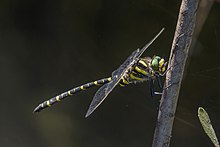The golden-ringed dragonfly (Cordulegaster boltonii) is a large, striking species of dragonfly found widely in Europe and locally in northwestern Africa, especially near flowing waters like streams.[1] It is the longest British species of dragonfly,[2] and the only member of its genus to be found in the United Kingdom.[3]
| Golden-ringed dragonfly | |
|---|---|

| |
| Male in Fermyn Woods, Northamptonshire, UK | |

| |
| Female in Arne, Dorset, UK | |
| Scientific classification | |
| Domain: | Eukaryota |
| Kingdom: | Animalia |
| Phylum: | Arthropoda |
| Class: | Insecta |
| Order: | Odonata |
| Infraorder: | Anisoptera |
| Family: | Cordulegastridae |
| Genus: | Cordulegaster |
| Species: | C. boltonii
|
| Binomial name | |
| Cordulegaster boltonii (Donovan, 1807)
| |
| Synonyms | |
| |
Identification edit
In the United Kingdom, they are easily identified by their distinctive black and yellow stripes, which is not found in any other dragonfly in the country.[4] A very large species, males average 74 mm (2.9 in) and the longer females average 84 mm (3.3 in). Wingspan is up to 101 mm (4.0 in).[5] The female is the longest British dragonfly, in part due to the unusually long ovipositor,[2] and in other measurements it is exceeded by the emperor (Anax imperator).[6]
Larvae edit
The female lays the eggs in shallow water. The hairy larvae live at the bottom of the water and are well camouflaged amongst the silt.[7] They emerge after about 2–5 years, and usually under the cover of darkness.
Behaviour edit
They are often seen flying leisurely over mountain streams or a river; they also occasionally show up at a pond. They are also typically seen flying over heath land. Their bright yellow and black stripes make them easy to identify, even from a fair distance away. They feed mainly on insects ranging from small prey such as midges to flies, butterflies and even bumblebees. This strikingly-coloured insect is incredibly aerobatic and they sometimes fly very high up into the sky.[8]
See also edit
References edit
- ^ a b Paulson, D.R. (2020). "Cordulegaster boltonii". IUCN Red List of Threatened Species. 2020: e.T165509A140511553. doi:10.2305/IUCN.UK.2020-3.RLTS.T165509A140511553.en. Retrieved 11 November 2021.
- ^ a b "Cordulegaster boltonii". British Dragonfly Society. Retrieved 18 August 2010.
- ^ "Golden-ringed dragonfly (Cordulegaster boltonii)". ARKive. Archived from the original on 2007-11-13. Retrieved February 7, 2008.
- ^ "UK Safari". Retrieved 2008-02-07.
- ^ "Golden-ringed dragonfly videos, photos and facts - Cordulegaster boltonii - ARKive". Archived from the original on 2013-12-04. Retrieved 2013-11-27.
- ^ "Emperor". British Dragonfly Society. Retrieved 25 November 2023.
- ^ "Wild Scotland". Archived from the original on October 6, 2008. Retrieved 2008-02-07.
- ^ "Dragonflies at Plas Farm". Archived from the original on 2008-02-13. Retrieved 2008-02-07.
External links edit
- Media related to Cordulegaster boltonii at Wikimedia Commons
- Data related to Cordulegaster boltonii at Wikispecies
